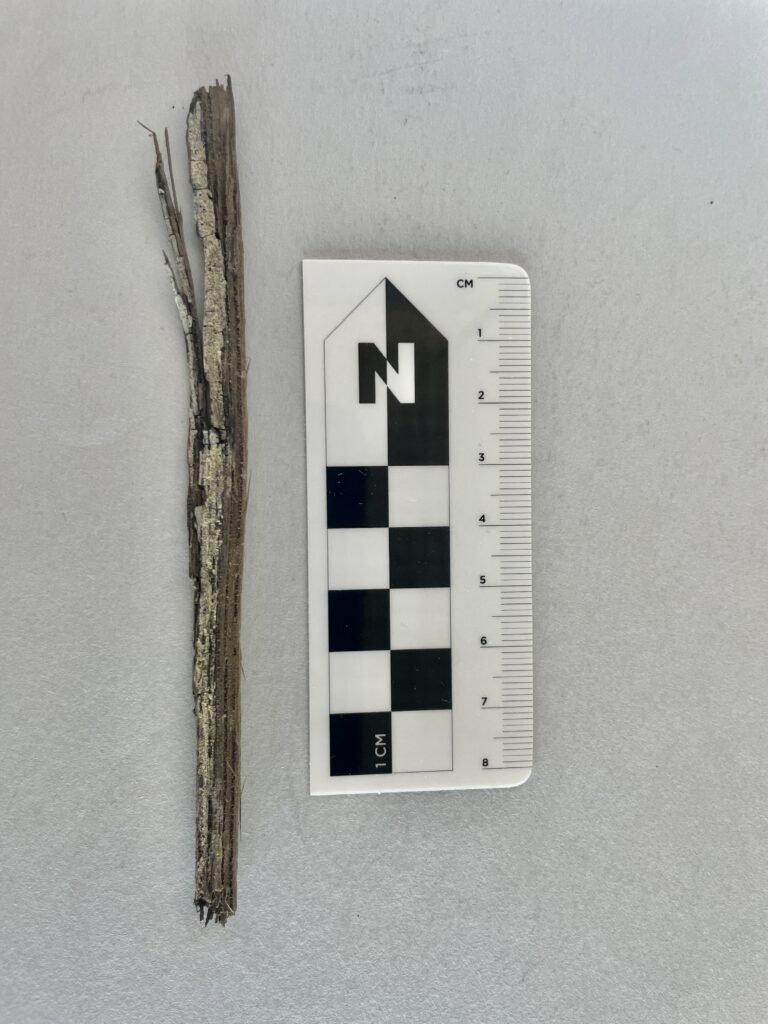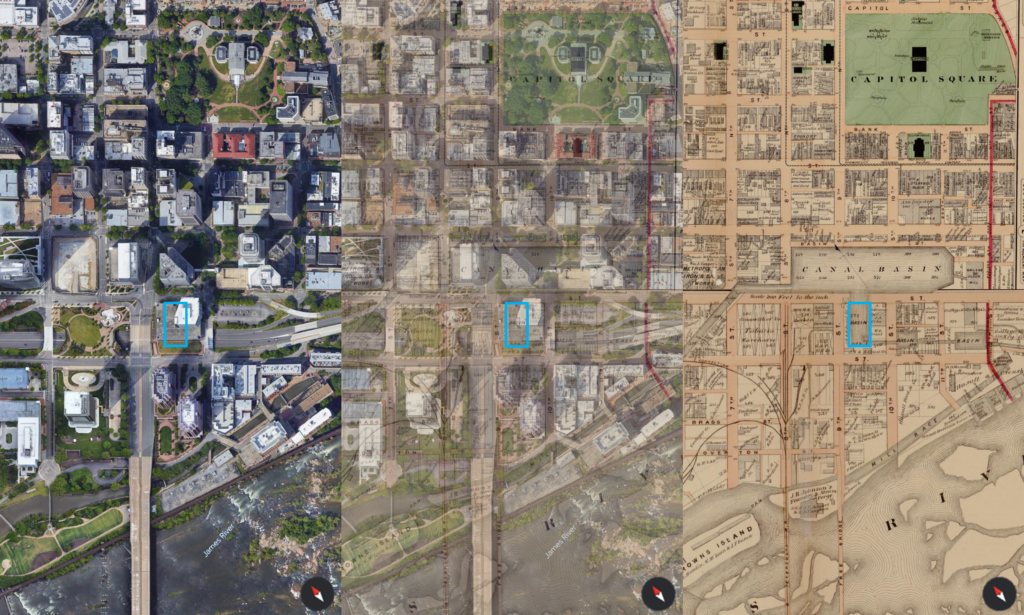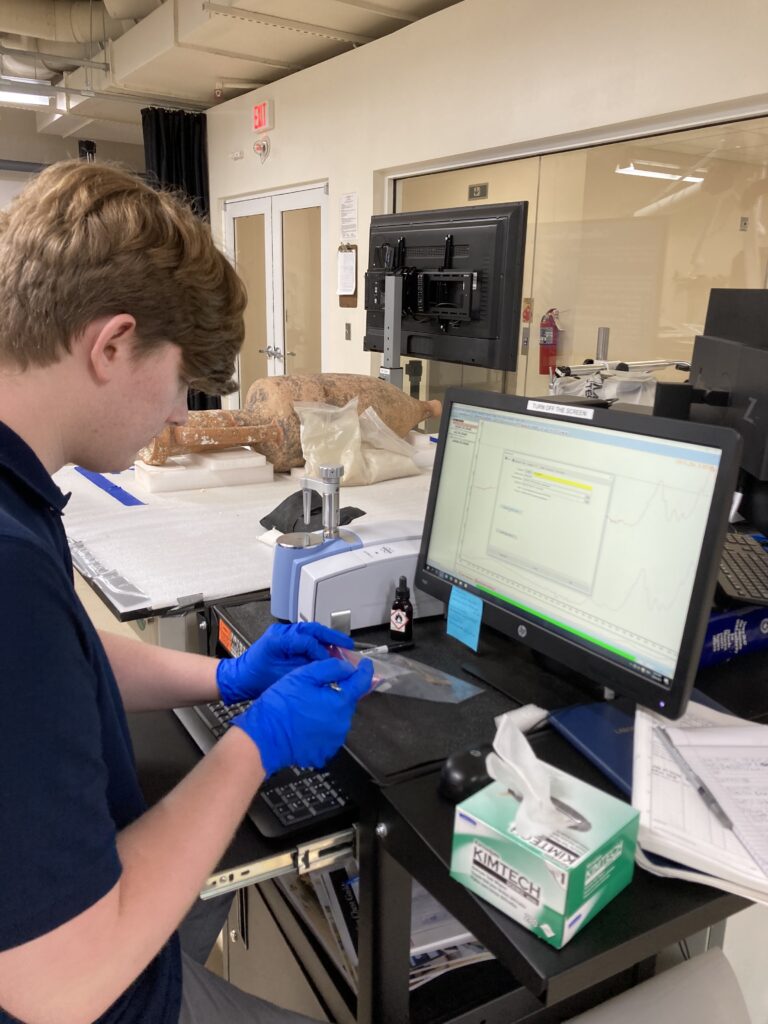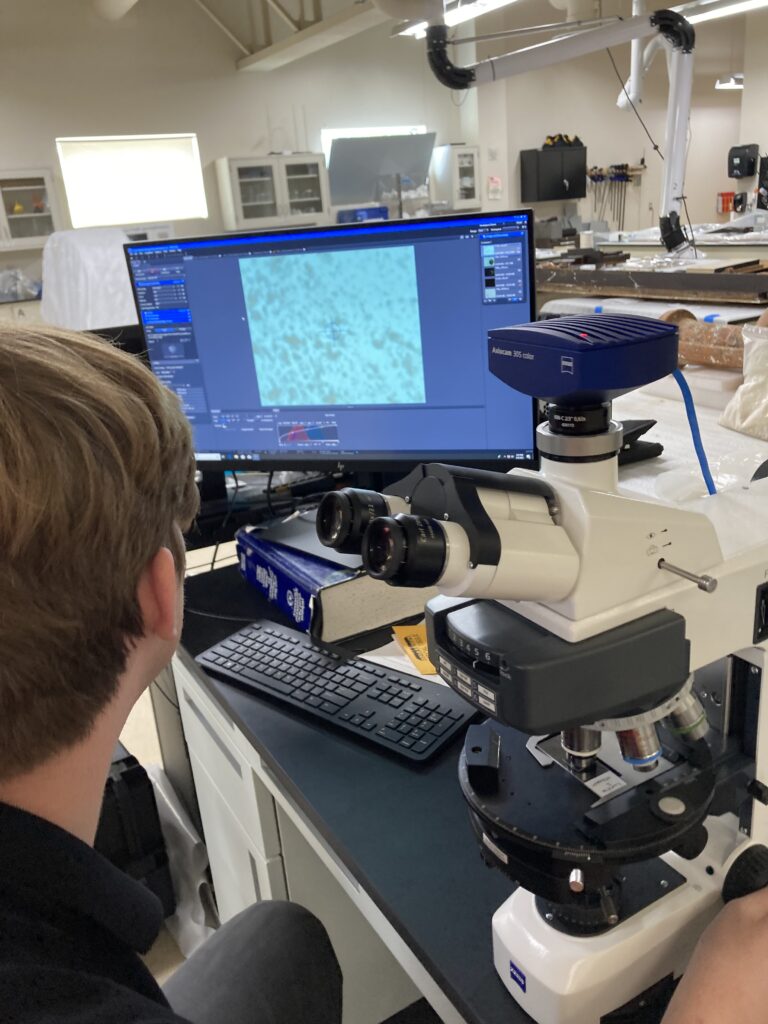Howdy folks! My name is Harrison Biggs, and this summer I have the privilege of working in the Conservation Department at The Mariners’ Museum and Park as The Bronze Door Society’s Conservation Science Intern. For 10 weeks, I have been working closely with Dr. Molly McGath on a variety of analytical projects, as well as helping to monitor the desalination tanks in the Batten Conservation Complex Wet Lab.
One of the bigger projects I’ve been working on this summer is in partnership with the Virginia Department of Historic Resources (DHR). State Archaeological Conservator Katherine Ridgway and State Underwater Archaeologists Brendan Burke and Jill Schuler recently visited us in the Lab and brought us a wood fragment from a damaged section of a boat in the collection of The Virginia Canals and Navigations Society (VCNS).

VCNS excavated the midsection of the boat in 1990 during the construction of the Williams Mullen building between 9th Street and 10th Street in Richmond, above the downtown expressway (around a quarter mile from the James River). This area was once part of the city’s canal system, and served to connect the Great Basin to the locks that provided access to the James River.

The boat is built from straight planks and mainly uses mortise and tenon joints (where a protrusion on one piece, the tenon, fits into a hole; the mortise, on another) with few fasteners. It has an estimated width of around eight feet, but since only a fragment of the hull was found (the bow and stern are either still buried, or were destroyed during construction), the total length is unknown. The outside of the boat is covered in a flakey white material that bonds tightly to the wood (either a paint or some form of deposit that occurred during use or while it was buried). The boat likely dates to sometime in the early 1800s, as it was found in a part of the canal that was walled off early in the century (Trout, 1997, 82).
Over the years, there have been four proposed interpretations of what the boat could be. Initially, during excavation, Dr. William Trout, a founding member and former president of VCNS, who participated in the excavation, identified the boat as a gundalow, a type of riverboat that was common on the Shenandoah River from the late 18th century to the middle of the 19th century. Prior to this period, the Shenandoah was considered unnavigable; the waters were shallow, and the river was filled with rocks, rapids and sharp bends that made navigation difficult and dangerous (Bruggeman, 2000, 11-12).
Gunadalows were designed to meet these challenges. They were built to be long and wide, with a flat bottom and limited mass to give them the smallest possible draft. The river’s complexity meant that it was ultimately cheaper for boatmen to steer their boats and cargo down the river and then walk home and buy a new boat. To recoup some cost, gundalows would be sold as lumber at their destination, and, though rare, buildings from this period were occasionally built from gundalow wood (the most notable of these is the Coons building near Arsenal Square in Harper’s Ferry, West Virginia).
Gundalows were built simply, and from straight boards, to make them easier to construct, dismantle, and sell as lumber. This gave them distinctive square ends. Due to the impermanence of this style of boat, no intact examples have ever been found. If this is the correct interpretation of the boat found by VCNS, it would be the first of its kind to be documented in the archaeological context.
Like the Shenandoah River, the James River is shallow with fast moving water that runs over a number of rocks and rapids (though it’s a little bigger, and winds less). Given the similarity between the two, and the proximity of their headwaters in the Shenandoah Valley, it’s not unlikely that a gundalow navigated the James River, but there is currently little evidence that that was ever the case.
Instead, the more easily navigable James River was usually navigated by a more permanent style of boat known as a batteau (plural batteaux). Being intended for multiple uses, batteaux were built with more care than gundalows and made use of curved boards, coming to a point at the bow like a more typical boat (Terrell, 1988). This interpretation is unlikely given the dissimilarities between known batteaux and the VCNS boat, but it is still a possibility given the popularity of batteaux on the James.
Besides the gundalow and the batteau, Brendan Burke has pointed out two additional possible interpretations. The first possibility is that the VCNS boat represents a new type of single-use boat; meant to be sailed down the river and disposed of or sold for parts at the destination like the gundalow. The second option is that we are looking at an example of a “flat-pack” boat. This hypothesis is based on the fact that the boat has features consistent with permanent boats (i.e. the potential paint on the outside) and single-use boats (i.e. the unfastened joints). While there is currently no precedent for either of these boat styles in Virginia, the VCNS boat is unique enough to bring this into the realm of possibility.
Ultimately, too much of the VCNS boat is missing to make a judgment on form alone, so we are required to rely on other aspects of the boat in order to identify it. At present, the most compelling detail that could shed some light on the boat’s identity is the white material on the object’s surface. Currently, it is unclear whether the material was applied intentionally like a paint or unintentionally like mud from a river bed. We think it’s unlikely that a single-use boat like a gundalow would have been painted. Why would someone go through the effort of painting something meant to be disposed of or sold as lumber? We believe that identifying the surface material will shed some light on the identity of the boat. Specifically, the thinking is that if we are able to identify the surface material as something consistent with intentional application, we would have reason to believe that the boat is of a style meant for multiple uses like the batteau or the flat-pack. Conversely, if the surface material is consistent with unintentional deposit, then we would have reason to believe that it was meant for a single use.
TIME TO SCIENCE!
Our efforts to identify the surface material has mainly involved two techniques: attenuated total reflectance-Fourier-transform infrared spectroscopy (ATR-FTIR) and polarized light microscopy (PLM).
We started with ATR-FTIR. Using a scalpel, we scraped a small amount of the white material from the surface of the sample onto the spectrometer’s diamond cell. We then clamped the sample down against the cell, and had the instrument collect a spectrum. The machine then shines a beam of infrared light at the sample through the cell. Chemical bonds in the sample absorb certain frequencies of this beam (the specific frequency depends on the elements in the bond), and reflect the rest. The reflection is captured by the instrument, which then reports how much light was absorbed at each frequency as peaks on a spectrum.
By comparing the spectrum to reference data collected from known materials in other labs, we can make guesses at the identity of our unknown material. This process is complicated when looking at mixed materials, as the spectrometer doesn’t distinguish between individual constituents. Case in point, our initial analysis showed that the spectra we collected were okay matches for reference data for verona green earth (a natural green pigment from Italy), but not enough for a positive identification. This did open a new avenue of investigation though, and lately we have been comparing our sample to other natural minerals like mica, silica, and chalk.

To support our ATR-FTIR analyses, we’ve been looking at our sample and a number of reference materials in PLM, which shows us how materials bend and interact with light. To do this, we take a small amount of material (less than the size of a grain of sand), and mount it on a glass slide using a transparent, caramel-like material with a known refractive index called Meltmount. We then put our slide under a microscope between two perpendicular polarizers. This causes the material to shimmer in ways that are characteristic to the specific material. PLM is incredibly time consuming with slide mounting in the fume hood, and then about 15 visual tests per sample, some of which look at details so small, they can be hard to see even under 100x magnification.

As we’ve been working through other techniques, we’ve also been looking at x-ray fluorescence (XRF) spectra provided by Katherine Ridgway. This technique gives us an idea of the elements present (and their relative concentrations) in a sample by firing an x-ray beam at the sample. This ejects electrons from their orbit around an atom, opening space for others to get closer. As they do so, these new electrons release energy in the form of light, the frequency of which is characteristic to the atom they orbit, which are detected by the instrument.
The spectra collected by Katherine Ridgway show that the surface material has lots of iron in it, with small concentrations of silicon, sulfur, calcium, and a very small amount of titanium (importantly, no elements lighter than aluminum will appear in XRF spectra because the light they release doesn’t have enough energy). This corroborates the conclusion from our ATR-FTIR data that the surface material is probably mineral based. It is not a white pigment though, which we would expect to contain significant amounts of zinc, lead, barium, or titanium. This information also allows us to narrow down the materials we look at with other techniques; there’s not enough calcium for materials like chalk to be primary constituents.
Unfortunately, we don’t yet have any concrete results that point to either intentional painting or use/burial deposition of this material, but we think that the white material might contain kaolinite (among other things). Kaolinite is a common mineral often found in clayey soils with a number of uses in pigments and paints. This could point to either application case: it could have been part of a coating that someone applied to the boat or could have been deposited naturally as the boat scraped along a shallow river bead (or, indeed, as it sat underground for almost 200 years). At this time, the answer is not clear, though we are leaning towards the intentional application given how tightly bound the material is to the wooden surface. Either way, there’s a lot more work to be done before we can say anything with any certainty.
Over the next few weeks, we’ll be collecting more ATR-FTIR spectra, and comparing additional materials under PLM. If we’re lucky, we’ll come out the other side of our analyses with a good idea of the surface material’s identity, and maybe a greater understanding of the history behind the VCNS boat. It’s important to note that our findings won’t necessarily negate any interpretation of the boat. It’s possible someone painted a single-use boat, and it’s possible a multiple-use boat received an unintended deposit. The goal of our work is not to answer this question outright, but to offer new information that will help those with more knowledge in the subject draw a conclusion.
ENDNOTES
Special thanks to the Virginia Canals and Navigations Society and the Virginia Department of Historic Resources for making this work possible; to Brendan Burke, William Hoffman, Katherine Ridgway and Molly McGath for helping me pull this blog post together; and to Molly McGath for giving me the opportunity to work with her on this project.
BIBLIOGRAPHY
Trout, William. The Shenandoah River Atlas. Lexington: The Virginia Canals and Navigations Society, 1997.
Bruggeman, Seth. “The Shenandoah River Gundalow and the Politics of Material Reuse.” Master’s thesis, The College of William and Mary, 2000.
Bruggeman, Seth. “The Shenandoah River Gundalow: Reusable Boats in Virginia’s Nineteenth-Century River Trade.” The Virginia Magazine of History and Biography 118, no. 4 (2010): 315-349.
Terrell, Bruce. “The James River Batteau: Tobacco transport in Upland Virginia 1745-1840.” Master’s thesis, East Carolina University, 1988.
Trout, William. “Let’s Roll a Hogshead!” accessed June 29, 2023, https://scottsvillemuseum.com/transportation/homehogshead.html